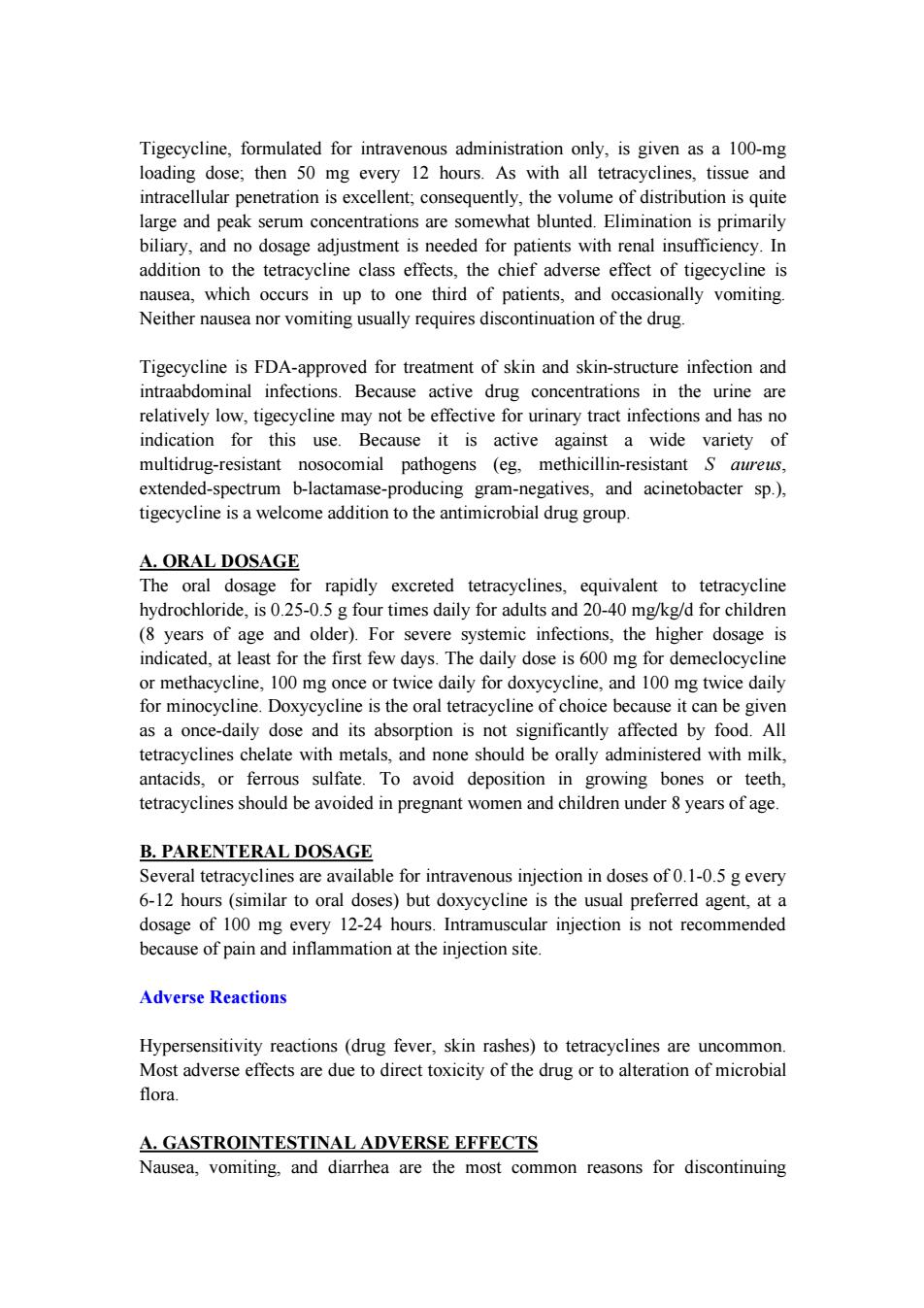正在加载图片...

Tigecycline,formulated for intravenous administration only,is given as a 100-mg loading dose;then 50 mg every 12 hours.As with all tetracyclines,tissue and intracellular penetration is excellent;consequently,the volume of distribution is quite large and peak serum concentrations are somewhat blunted.Elimination is primarily biliary,and no dosage adjustment is needed for patients with renal insufficiency.In addition to the tetracycline class effects,the chief adverse effect of tigecycline is nausea,which occurs in up to one third of patients,and occasionally vomiting. Neither nausea nor vomiting usually requires discontinuation of the drug. Tigecycline is FDA-approved for treatment of skin and skin-structure infection and intraabdominal infections.Because active drug concentrations in the urine are relatively low,tigecycline may not be effective for urinary tract infections and has no indication for this use.Because it is active against a wide variety of multidrug-resistant nosocomial pathogens (eg,methicillin-resistant S aureus, extended-spectrum b-lactamase-producing gram-negatives,and acinetobacter sp.), tigecycline is a welcome addition to the antimicrobial drug group A.ORAL DOSAGE The oral dosage for rapidly excreted tetracyclines,equivalent to tetracycline hydrochloride,is 0.25-0.5 g four times daily for adults and 20-40 mg/kg/d for children (8 years of age and older).For severe systemic infections,the higher dosage is indicated,at least for the first few days.The daily dose is 600 mg for demeclocycline or methacycline,100 mg once or twice daily for doxycycline,and 100 mg twice daily for minocycline.Doxycycline is the oral tetracycline of choice because it can be given as a once-daily dose and its absorption is not significantly affected by food.All tetracyclines chelate with metals,and none should be orally administered with milk, antacids,or ferrous sulfate.To avoid deposition in growing bones or teeth, tetracyclines should be avoided in pregnant women and children under 8 years of age. B.PARENTERAL DOSAGE Several tetracyclines are available for intravenous injection in doses of 0.1-0.5 g every 6-12 hours (similar to oral doses)but doxycycline is the usual preferred agent,at a dosage of 100 mg every 12-24 hours.Intramuscular injection is not recommended because of pain and inflammation at the injection site Adverse Reactions Hypersensitivity reactions(drug fever,skin rashes)to tetracyclines are uncommon. Most adverse effects are due to direct toxicity of the drug or to alteration of microbial flora A.GASTROINTESTINAL ADVERSE EFFECTS Nausea,vomiting,and diarrhea are the most common reasons for discontinuingTigecycline, formulated for intravenous administration only, is given as a 100-mg loading dose; then 50 mg every 12 hours. As with all tetracyclines, tissue and intracellular penetration is excellent; consequently, the volume of distribution is quite large and peak serum concentrations are somewhat blunted. Elimination is primarily biliary, and no dosage adjustment is needed for patients with renal insufficiency. In addition to the tetracycline class effects, the chief adverse effect of tigecycline is nausea, which occurs in up to one third of patients, and occasionally vomiting. Neither nausea nor vomiting usually requires discontinuation of the drug. Tigecycline is FDA-approved for treatment of skin and skin-structure infection and intraabdominal infections. Because active drug concentrations in the urine are relatively low, tigecycline may not be effective for urinary tract infections and has no indication for this use. Because it is active against a wide variety of multidrug-resistant nosocomial pathogens (eg, methicillin-resistant S aureus, extended-spectrum b-lactamase-producing gram-negatives, and acinetobacter sp.), tigecycline is a welcome addition to the antimicrobial drug group. A. ORAL DOSAGE The oral dosage for rapidly excreted tetracyclines, equivalent to tetracycline hydrochloride, is 0.25-0.5 g four times daily for adults and 20-40 mg/kg/d for children (8 years of age and older). For severe systemic infections, the higher dosage is indicated, at least for the first few days. The daily dose is 600 mg for demeclocycline or methacycline, 100 mg once or twice daily for doxycycline, and 100 mg twice daily for minocycline. Doxycycline is the oral tetracycline of choice because it can be given as a once-daily dose and its absorption is not significantly affected by food. All tetracyclines chelate with metals, and none should be orally administered with milk, antacids, or ferrous sulfate. To avoid deposition in growing bones or teeth, tetracyclines should be avoided in pregnant women and children under 8 years of age. B. PARENTERAL DOSAGE Several tetracyclines are available for intravenous injection in doses of 0.1-0.5 g every 6-12 hours (similar to oral doses) but doxycycline is the usual preferred agent, at a dosage of 100 mg every 12-24 hours. Intramuscular injection is not recommended because of pain and inflammation at the injection site. Adverse Reactions Hypersensitivity reactions (drug fever, skin rashes) to tetracyclines are uncommon. Most adverse effects are due to direct toxicity of the drug or to alteration of microbial flora. A. GASTROINTESTINAL ADVERSE EFFECTS Nausea, vomiting, and diarrhea are the most common reasons for discontinuing